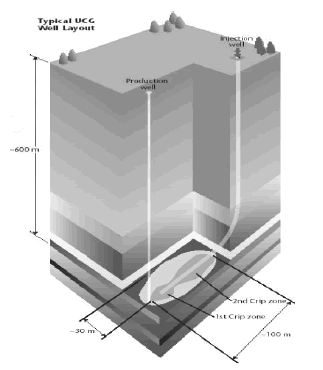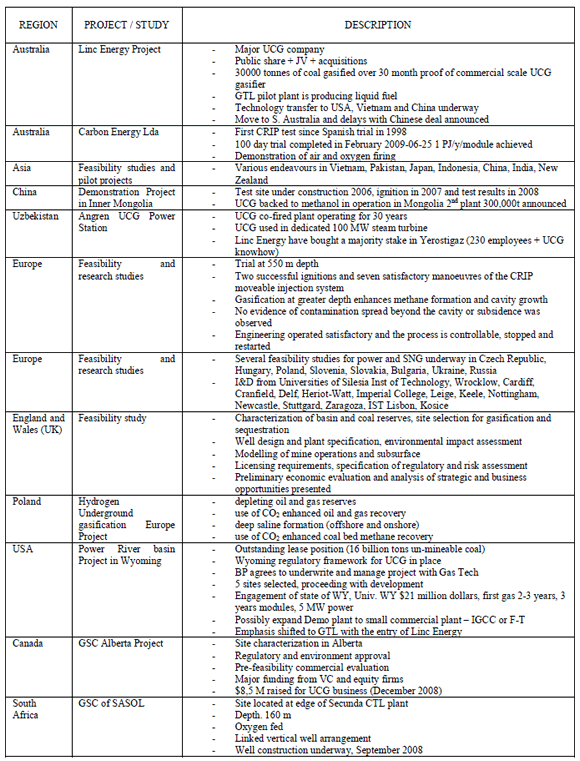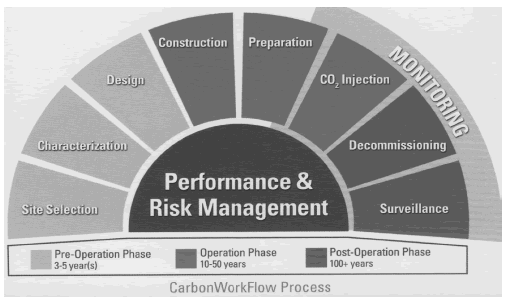TECHNOLOGICAL INNOVATIONS ON UNDERGROUND COAL GASIFICATION AND CO2 SEQUESTRATION
Palabras clave:
Underground, coal gasification, CO2 capture, CO2 sequestration, sustainability, sustainability index. (es)TECHNOLOGICAL INNOVATIONS ON UNDERGROUND COAL GASIFICATION AND CO2 SEQUESTRATION
LAS INNOVACIONES TECNOLÓGICAS EN GASIFICACIÓN SUBTERRÁNEA DE CARBÓN Y LA SECUESTRACIÓN DEL CO2
CARLOS DINIS DA GAMA
IST,
Technical University of Lisbon, Portugal, dgama@ist.utl.pt
VIDAL NAVARRO TORRES
IST,
Technical University of Lisbon, Portugal, vntorres@ist.utl.pt
ANA
PAULA FALCÃO NEVES
IST,
Technical University of Lisbon, Portugal, pfalcaoneves@mail.ist.utl.pt
Received for review June 30 th, 2009, accepted December 12 th, 2009, final version December 21 th, 2009
ABSTRACT: A brief description of the underground coal gasification (UCG) process, combined with the possibility of CO2 sequestration, is presented. Although nowadays there are very few active industrial UCG plants, a number of new projects are under way in different parts of the world aimed to produce regular gas fuel derived from in situ coal combustion, despite the environmental advantages resulting from this process. A brief review of those projects is included. The possibility of underground CO2 storage, either with or without simultaneous UCG, is analyzed by taking into consideration the main challenges of its application and the risks associated with integrated solutions, thus requiring innovative solutions.
KEYWORDS: Underground, coal gasification, CO2 capture, CO2 sequestration, sustainability, sustainability index.
RESUMEN: Se describen las principales contribuciones al desarrollo tecnológico del proceso de gasificación subterránea del carbón (G.S.C.) y complementariamente la posibilidad de secuestración del CO2 en el medio ambiente subterráneo. Se busca explicar por que razones existen actualmente en el mundo muy pocas plantas industriales de G.S.C. que produzcan regularmente combustibles gaseosos oriundos de la combustión del carbón in situ, a pesar de las ventajas de protección ambiental que resultan de este proceso. Un breve listado de los proyectos en curso es incluido. La posibilidad del almacenamiento subterráneo del CO2 con o sin simultaneidad respecto a la G.S.C. es analizada, destacando las principales dificultades de aplicación de esta técnica y los riesgos asociados a las soluciones integradas, que necesitan soluciones de innovación.
PALABRAS CLAVE: Subterránea, gasificación del carbón, captura de CO2, secuestración del CO2, índice de sostenibilidad.
1. INTRODUCTION
Technological innovations are creative business practices for the development of new processes, products or methodologies, which are essential for success in todays world, in all industrial areas, including the mining sector.
The main reasons for this trend are due to the increasingly intense trend of globalization, leading to exacerbate competition procedures, under the growing power of public opinion and environmental constraints.
Thus, new skills in training young engineers are required to ensure new technological achievements in that sector.
The origin and perpetual need for innovation is linked to the deepest human aspirations, as it was proclaimed by many writers, among others Von Goethe (1749-1832): "Over time, the reason becomes senseless and privileges, disturbances", George Duhammel (1884-1966): "The world was created to be recreated" and recently, Peter F. Drucker: "Our only habit is the constant changing".
In the field of mining, the majority of known innovations are related to:
- Use of clean, non-intrusive, technologies;
- Using BATNEEC ("Best Available Technology Not Enticing Excessive Costs");
- Environmental rehabilitation simultaneous with exploitation;
- Close involvement with local communities;
- New contributions to social cohesion and regional development.
It is also important to mention the Milos Declaration [1], which contains the fundamental survival principles of the mining sector in the 21st Century and beyond.
2. PRINCIPLES OF UNDERGROUND COAL GASIFICATION
2.1 History
This
technique had started in Russia during the 30s, consisting of the opening of
vertical drill-holes to intersect a coal seam at a certain depth, then injecting
air or oxygen and / or steam at high temperature to cause an underground combustion.
The resulting gases were extracted from the combustion chamber through other
boreholes, thus creating an in situ coal gasification to produce CO and
hydrogen at high pressure for use in electrical generating plants or in the
production of chemicals [2] (Figure 1).

Figure
1. Phases and process of Underground Coal
Gasification: drilling, injection and production [1,2]
The advantages of this technique are related to its high efficiency, because it makes possible to triple or quadrupling the exploitable coal reserves and so offsetting the decline in reserves of other mineral fuels such as oil and gas. This is particularly suitable for low quality coals, such as lignite and bituminous coal, which produce less heat in combustion due to its high ash content and are they more polluting in conventional plants.
Another important advantage is that the ashes of combustion remain underground, which reduces emissions of NOx and SOx pollutants, as well as mercury levels and particulate pollution, compared to conventional coal thermal units, with additional economic benefits.
In this way, chemical reactions can produce a gas rich in carbon monoxide, hydrogen and other elements such as methane. This gas can be used to generate electricity or as fuel and the coal used need not be a high calorific value, although their optimal use is also dependent on geological features (faults, folds, weathering, etc.) of the adjacent ground, particularly the formations located above the combustion chamber.
2.2 The
CRIP innovation
Several
processes exist to initiate and control UCG reactions, including the Controlled
Retraction Injection Point (CRIP) process, developed by the Lawrence Livermore
National Laboratory (LLNL) for shallow coal and the European trial extended its
use to deeper coal.
These ignition processes create a syngas stream which is compositionally similar to surface-produced syngas. It can have higher CO2 content and hydrogen products due to a number of factors, including a higher than optimal rate of water flux into the UCG reactor and ash catalysis of water-gas shift. Because of the nature of in-situ conversion, UCG syngas is lower in sulfur, tar, particulates and mercury than conventional syngas and has very low ash content. Other components are similar and can be managed through conventional gas processing and clean up (Figure 2).

Figure
2. Schematic representation of the CRIP
technique [3]
2.3 Economics
The
economics of UCG appear extremely promising. The capital expenses of UCG plants
appear to be substantially less than the equivalent plant fed by surface
gasifiers because plant purchase is not required. Similarly, operating expenses
are likely to be much lower because of the lack of coal mining, cleaning and
transportation, thus significantly reducing ash management facilities. Even for
configurations requiring a substantial environmental monitoring program and
additional swing facilities, UCG plants retain other economic advantages:
- It can serve to spread the use of hydrogen as a clean fuel, thus exploiting further layers than in conventional hard coal underground mining;
- It takes the energy contained in coal without the need to remove it and avoid technical problems and safety of conventional mining;
- As the ashes and other undesirable components remain in the reservoir, this means great savings in terms of surface waste disposal;
- Coal gasification plants are more energy efficient that conventional combustion (50% greater), and experts believe that in forthcoming years they can reach 70 or 80% higher performances;
- Carbon dioxide, a leading greenhouse gas, can be captured by chemical processes in ways that do not let it escape to the atmosphere.
2.4 Environmental effects and sustainability
There are
two primary, short-term environmental hazards associated with UCG: ground-water
contamination and surface subsidence. Both of these, according to LLNL, appear to
be avoidable through careful site selection and management. Those negative
environmental effects may influence the quality of groundwater resources
whereas surface subsidence may be induced by the cavities produced by coal
combustion, although these problems are known to decrease with the depth of the
reservoir.
In similarity to the mining industry and as any other human activities the UCG process must be carried out in concordance to the sustainable development (SD) principles. The key for SD of the UCG is comprised of the three "basic pillars" economic, social and environmental (Figure 3).

Figure
3. Interactions of mining sustainable development components [4]
The overall quantification of the Sustainable Development (SD) in UCG is a very complex task, so the management based on a Sustainability Index is an important way to implement it in practical terms, in order to involve a large amount of intervening parameters along the life cycle of the UCG process, by considering the permissible levels of sustainability [4].
In the future, Underground Coal Gasification will be an important activity for human society development, so the projects in this area must be carried out with acceptable environmental sustainability principles.
2.5 Directional
drilling innovations
Initially,
gasification was normally conducted by two vertical wells, one for injecting
the combustion agents and the other one to recover the resulting gases.
However, in some cases it was very difficult to connect between the two wells.
At present, oil drilling technology has enabled a much greater advantage by
means of drilling deviated, inclined or horizontal boreholes, which can connect
the injection well directly to the recovery of the gases.
This system, called gasification channel, was experienced between 1992 and 1999 in Spain , specifically in the mine Alcorisa (Teruel). For this purpose, a company was established by organizations from Spain , UK and Belgium , under the support of the European Commission.
2.6 The EU Research Program
Results of
this field testing program, according to its promoters, showed that the system
was operational and that several identified problems were simple to solve. The
sub-bituminous coal was suitable for the combustion experiment at a depth of
600 meters, with a 30
degree inclination.
Preliminary outcomes indicated that the resulting gas had high methane content, as well as hydrogen and carbon monoxide, with an average calorific value 10.1 MJ / kg. The production rate was 2.5 megawatts, with a maximum of 7.5 megawatts.
2.7 Projects in other countries
In the UK, the
Department of Trade and Industry aimed at developing a British gasification process
as a technology for future energy use of coal, both at land and located under the
North Sea. Currently, China seems to be the first to invest in this technology, with at least 30 projects
in various stages of implementation. India also have plans to use this
technique to produce energy and chemicals from the massive reserves, estimated
at 350,000 million tons, discovered in the states of Gujarat and West Bengal.
Part of the generated CO2 is injected into oil fields to increase production of heavy oil discovered in Gujarat. This was already being done at Dakota Gasification plant between Canada and the USA. According to information from an Indian report, 2015 will come into operation on 3 floors of commercial coal gasification site. Other countries like United Kingdom , USA , Australia and South Africa have also shown interest in this process. According to Green [3], some of the most important current projects are mentioned in Table 1.
Table
1. Main UCG current projects in the world [3,7,8,9]

3. UNDERGROUND CO2 SEQUESTRATION
In recent years a warning has sounded on the excessive emission of greenhouse gases (GHGs), especially carbon dioxide, due to heavy industrial production. Many scientists link directly this excess of CO2 in the atmosphere with climate changes due to greenhouse gases that are causing temperature increases. Possible solutions would be in the promotion of the natural carbon sinks when they have ceased to perform its function due to human action.
According to experts, carbon dioxide remains are stored in the oceans, vegetation and soil. It is known that soil stores between 2 and 20 times more of these greenhouse gases that earth vegetation.
In fact, the emissions market share can generate CO2 by planting trees but not sink it into the ground. However, the soil sink is a much more stable and has more storage capacity. Thus, there are soils that are acting as net sinks, meaning that they only absorb CO2 and emit no pollutants and others that are more dynamic and perform both functions at once. Given this, it naturally enhances its absorption into the soil through revegetation and enhancement of agricultural activities.
This is a partial solution to the problem because the most important way is to reduce emissions which will require a considerable change in human societys way of life.
During the past ten years there has been some research efforts devoted to the direct effects of ocean storage of CO2 in the seabed [5], where the typical deep ocean account for a storage depth of 3000m water.
In case of carbon dioxide leakage under the sea, and in contrast to the case of invasion from the atmosphere, available monitoring techniques may be applied efficiently.
The involuntary leakage of CO2 can change the sea chemistry with local consequences larger than those derived from the invasion of the atmosphere. Therefore, effects on the marine environment from the escape of CO2 from the seabed storage are considered difficult to control. Thus, it is the abduction of an underpass as the most viable options for resolving this problem. Figure 4 presents the recent contributions to develop the technique of underground storage [6].

Figure
4. The main stages of SSC and their expected duration [6, 10]
4. UCG ASSOCIATED WITH CO2 SEQUESTRATION
Other underway projects are seeking to include CO2 sequestration on the cavity from which the coal was extracted [10]. The CO2 capture takes place at high pressure before combustion plant for its separation and storage, using the same technology of drilling and completion than UCG. At depths of over 1000m also operates under the same pressures that are necessary for the phase of high density storage of CO2. The synergy is even greater if the same process for gasification wells can be reused, after modification, for its storage.
Thus, if a series of wells are open in a UCG chamber for the production of synthesis gas which will separate CO2 contents and re-injected them through abandoned wells to appropriate underground structures suitable for permanent storage. The fuel would be produced efficiently for use in gas turbines of combined cycle or fuel cells and therefore emissions would be zero in the case of hydrogen or near zero for the hydrogen-methane mixtures.
Underground storage of CO2 is able to meet all minimum standards for leakage prevention.
It is possible to demonstrate that a deep well UCG can be reused with or without modification, for injection and permanent storage of CO2. The target for storage may also be located in the coal seams, the upper layers or an abandoned UCG cavity. Preliminary estimates indicate that at depths greater than 1500m, all the CO2 produced from coal can be restored.
5. CONCLUSIONS
The GSC and SSC processes are of great importance for humanity, particularly if they are well-adjusted technologies for developing a permanent and unquestionable economic feasibility, with the advantage of creating reduced environmental impacts. Future developments are full of challenges and achievements, as it is typical of the greatest human endeavors.
The U.E. has re-implemented in 2008, the "Research Fund for Coal and Steel" with a priority to the use of clean energy sources and apply new techniques for gasification and liquefaction, as an incentive for scientists and engineers who intend to devote their abilities to these issues.
REFERENCES
[1] NAVARRO TORRES; V.F. AND DINIS DA GAMA; C. The Milos Declaration and Sustainable Development (in Portuguese). Journal INGENIUM II Series, Number 84 November/December 2004, pp. 56 59.
[2] NAVARRO TORRES V.F,Modelling and Optimisation of Underground Coal Gasification and CO2 Capture and Sequestration for Clean Energy in Europe. Proposal of European Young Investigator Awards EURYI Awards 2005
[3] GREEN, M., Overview of worldwide field activity and the Future of UCG. 4th International Conference on Underground Coal Gasification. UCG Partnership, London, February 10-11, 2009.
[4] DINIS DA GAMA, C. AND NAVARRO TORRES V.F, A mathematical model to assess an environmental sustainability index for the underground coal gasification process. 4th International Conference on Underground Coal Gasification. UCG Partnership, London, February 10-11, 2009.
[5] CALDEIRA, K. AND WICKETT, M.E, Ocean model predictions of chemistry changes from CO2 emissions and ocean to the atmosphere. J. Geophysical Research, 110, C09S04, DOI 10.1029/2004JC002671. 2005.
[6] SCHLUMBERGER CARBON SERVICES, Integrated solutions for long-term CO2 storage. London. 2007.
[7] WALKER, L., Underground Coal Gasification: A clean coal technology ready for development. The Australian Coal Review, October 1999.
[8] ROGUT, J., EU Project HUGE - the role and value of virtual and experimental approaches. 4th International Conference on Underground Coal Gasification. UCG Partnership, London, February 10-11, 2009.
[9] KEMPKA, T.; SCHLUTER, R.; AECKERSBERG, R.; TIAN, H.AND KROOSS, B., Carbon dioxide storage in in situ concerted coal seams Experimental Studies. 4th International Conference on Underground Coal Gasification. UCG Partnership, London, February 10-11, 2009.
[10] European Technology Platform for Zero Emission Fossil Fuel Power Plants (ZEP), CO2 Capture and Storage (CCS), a key solution for combating climate change. 2005.
Cómo citar
IEEE
ACM
ACS
APA
ABNT
Chicago
Harvard
MLA
Turabian
Vancouver
Descargar cita
Visitas a la página del resumen del artículo
Descargas
Licencia
Derechos de autor 2010 DYNA

Esta obra está bajo una licencia internacional Creative Commons Atribución-NoComercial-SinDerivadas 4.0.
El autor o autores de un artículo aceptado para publicación en cualquiera de las revistas editadas por la facultad de Minas cederán la totalidad de los derechos patrimoniales a la Universidad Nacional de Colombia de manera gratuita, dentro de los cuáles se incluyen: el derecho a editar, publicar, reproducir y distribuir tanto en medios impresos como digitales, además de incluir en artículo en índices internacionales y/o bases de datos, de igual manera, se faculta a la editorial para utilizar las imágenes, tablas y/o cualquier material gráfico presentado en el artículo para el diseño de carátulas o posters de la misma revista.

















